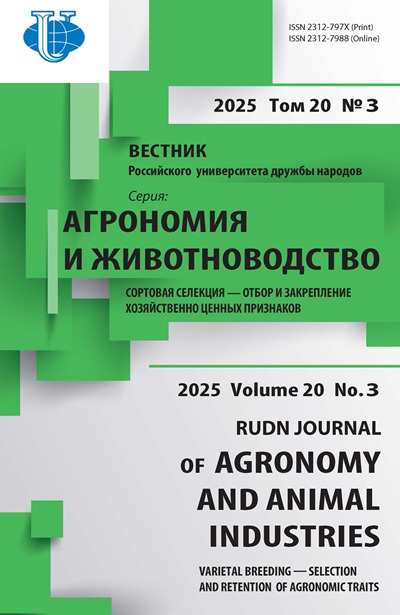From the editorial
- Authors: Pakina E.N.1
-
Affiliations:
- RUDN University
- Issue: Vol 20, No 3 (2025): Varietal breeding — selection and retention of agronomic traits
- Pages: 341-343
- Section: Varietal breeding — selection and retention of agronomic traits
- URL: https://agrojournal.rudn.ru/agronomy/article/view/20238
- DOI: https://doi.org/10.22363/2312-797X-2025-20-3-341-343
- EDN: https://elibrary.ru/ULIRGI
- ID: 20238
Cite item
Full Text
Abstract
-
Full Text
From the editorial
Modern approaches to the analysis of breeding-relevant traits in agricultural crops are opening new opportunities for the development of Russian cultivars with combined pathogen resistance and improved quality characteristics. The integration of molecular and genetic tools greatly accelerates the identification and selection of sources of valuable traits related to productivity, quality, and resistance to various stress factors, thereby facilitating the rapid development of a competitive and adaptive range of Russian crop varieties.
The scientific articles that comprise the main topic of this issue present the results of selection for agronomic plant traits and identification of genes for resistance to biotic factors. The authors of the article ‘Marker selection of promising varietal and breeding material of apple tree’ performed a phenotypic assessment for a range of key economic, biological, and adaptively significant traits and identified carriers of several apple scab resistance genes, which will serve as the basis for developing resistant varieties. The results obtained by the authors of the article ‘Resistance of spring wheat Triticum aestivum L. to leaf rust under the conditions of the Central Non-Black-Earth region’ indicate that the resistance genes present in the studied set of cultivars provide relatively effective protection in years with a low infection load, but their protection is insufficient during epiphytotic years. The article ‘Characteristics of selection traits in new accessions of spring barley Hordeum vulgare L. in the conditions of North-West Russia’ identifies sources of agronomic traits from the collection of the Federal Research Center of Vavilov Russian Institute of Plant Genetic Resources, based on the main elements of crop structure, to create valuable spring barley breeding material. The identified accessions will be used in the breeding process as genetic sources of economically valuable traits. The article ‘Food Security in the Russian Federation: realization of domestic demands amid export opportunities expansion’ also discusses the importance of developing Russian breeding to obtain Russian cultivars and hybrids necessary for increasing crop yields. The authors note the active development of the Russian market to produce Russian cultivars and hybrids for both open and protected ground. It is important to preserve existing agronomic traits in a population of homogeneous plants. In vegetatively propagated crops, green cuttings preserve the beneficial traits and properties of crops, fully reproducing the characteristics (color, shape, and size) of the parent plant. In the article ‘Technology of green cuttings of woody plants for landscaping Arctic cities’, the authors described a green cutting technology adapted for Arctic regions, which is crucial for advancement of cultivated plants in northern latitudes.
Ensuring Russia’s food sovereignty is inextricably linked to the progress of national plant breeding and seed production. This progress relies on the achievements of molecular genetic research directed toward the discovery and characterization of reliable sources of agronomically important traits and their effective incorporation into breeding programs. The studies presented in this thematic issue highlight contemporary approaches to addressing this strategically important challenge.
E.N. Pakina, Deputy Chief Editor
About the authors
Elena N. Pakina
RUDN University
Author for correspondence.
Email: pakina-en@rudn.ru
References
Supplementary files















